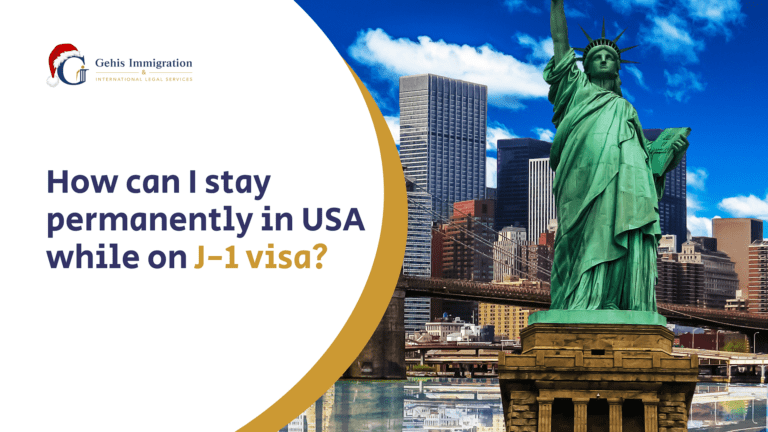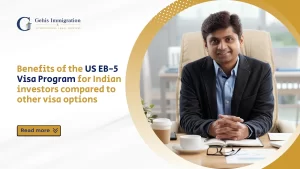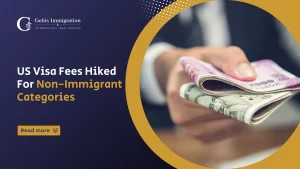How can I stay permanently in the USA while on a J-1 visa Status.
The United States Department of State supervises the J-1 visa program, allowing individuals to enter the country for educational and cultural enrichment. This program is an important means of promoting cross-cultural exchange. Even though the J-1 visa is intended to be a temporary solution, it is important for those who hold one to understand that they may eventually want to apply for permanent residency in the US. This article discusses the J-1 visa’s temporary status, the different requirements for obtaining permanent residency, and the importance of understanding the routes that can lead to more permanent status in the United States.
The J-1 visa is primarily intended for exchange visitors, allowing them to engage in educational and cultural programs, research, training, and other exchange activities. Understanding the foundational aspects of the J-1 visa is essential for individuals contemplating the possibility of transitioning to a more enduring immigration status.
What are the Eligibility Criteria for Permanent Residency?
Eligibility criteria for permanent residency in the United States can vary depending on the specific category under which an individual applies. Here’s a brief overview of some common pathways:
EB-1 (Employment-Based First Preference):
Individuals with extraordinary ability, outstanding professors, researchers, and multinational executives or managers are eligible.
Extraordinary ability includes achievements in the arts, sciences, education, business, or athletics.
EB-2 (Employment-Based Second Preference):
Professionals with advanced degrees or exceptional abilities in their field are eligible.
A National Interest Waiver (NIW) may be available for individuals whose work is deemed in the national interest.
EB-3 (Employment-Based Third Preference):
Skilled workers and professionals with less than two years of experience may qualify.
Labor Certification Process:
The labor certification is often part of the employment-based green card application, especially for EB-2 and EB-3 categories. It involves the employer demonstrating that no qualified U.S. workers are available for the job and that hiring a foreign worker will not adversely affect U.S. workers’ wages and working conditions.
Family-Based Options:
Spouses, unmarried children under 21 years old, and parents (if the sponsor is at least 21) of U.S. citizens qualify as immediate relatives.
Preference Categories (F1, F2A, F2B, F3, F4):
Family-sponsored preferences have numerical limits, and the availability of visas depends on the relationship between the petitioner (U.S. citizen or permanent resident) and the beneficiary (foreign national).
Diversity Visa Lottery Program:
The Diversity Visa (DV) Lottery Program, also known as the Green Card Lottery, is a random drawing that provides a chance for individuals from countries with low immigration rates to the U.S. to obtain a green card. Must meet education/work experience requirements (at least a high school education or two years of qualifying work experience). Entries must be submitted during the annual registration period.
It’s important to note that immigration laws and policies may change, so individuals considering applying for permanent residency should consult with an immigration attorney or the U.S. Citizenship and Immigration Services (USCIS) for the most up-to-date information.
What is Adjustment of Status vs. Consular Processing?
When living in the United States, qualified individuals can apply for lawful permanent resident status, also called a green card, through the Adjustment of Status (AOS) process, made possible by Form. Many immigrants are eligible to apply through this process, including asylees, refugees, and immigrants sponsored by their families or employers. Important steps in the AOS procedure include filing Form, which normally requires the applicant to be physically present in the country when filing. Applicants for Advanced Parole (AOS) may expedite their ability to work and travel by filing for employment authorization and travel permission (Advance Parole using Form simultaneously. Generally speaking, U.S. Citizenship and Immigration Services (USCIS) oversees the AOS process.
In contrast, consular processing, which requires applicants to apply through a U.S. embassy or consulate outside the country, provides an alternate method of obtaining an immigrant visa. Following issuing a valid visa, people enter the country and become permanent residents after being checked at a specific port of entry. The individual’s location, eligibility, visa availability, immigration history, timing, processing speed, flexibility, travel requirements, and unique circumstances are important factors that impact the decision between AOS and Consular Processing.
In particular, physically present people in the United States may choose to use AOS, whereas people who are not usually in the country usually use Consular Processing. Given that the decision can substantially impact the immigration process and a person’s ability to live and work in the United States, speaking with an immigration attorney is essential to evaluating unique circumstances and determining the best course of action.
How Do You Maintain J-1 Visa Status During the Transition?
Ensuring compliance with J-1 visa requirements is paramount for individuals in the United States on exchange visitor status. Failing to adhere to these regulations can result in severe consequences, including visa status violations, potential deportation, and complications for future immigration endeavors. J-1 visa holders must stay informed and fulfill their program obligations to facilitate a smooth transition while pursuing permanent residency.
Various options are available for extending J-1 visa status during the permanent residency process. Program extensions, when applicable, provide additional time for participants to fulfill their exchange program objectives, contingent upon approval by the program sponsor, with eligibility criteria varying by program category. Individuals subject to the two-year home-country physical presence requirement may explore J-1 waivers, offering alternatives such as government agency sponsorship, exceptional hardship or persecution claims, and participation in programs like the Conrad 30 for foreign medical graduates working in underserved areas.
In certain circumstances, J-1 visa holders may consider changing their status to another nonimmigrant category that aligns with their goals, involving filing a petition with U.S. Citizenship and Immigration Services (USCIS). Looking for alternative visa categories, such as the H-1B visa for temporary workers in specialty occupations, can offer additional time and flexibility during the permanent residency process. For those temporarily leaving the U.S. intending to return, consular processing provides a pathway to obtain a new J-1 visa or a different visa category.
Given the complications of immigration processes, seeking legal advice from an experienced immigration attorney is highly advisable. Attorneys can assess individual circumstances, explore available options, and offer strategic advice on maintaining legal status throughout the transition to permanent residency.
Final Word.
Obtaining permanent residency in the US requires a variety of routes, each designed to meet particular requirements. People can choose the route that best fits their qualifications, from employment-based options like EB-1, EB-2, and EB-3 to family preferences and the Diversity Visa Lottery. Two different pathways are available: Consular Processing and Status Adjustment, each with specific requirements. Maintaining J-1 visa status and dealing with program extensions and changes in visa categories require careful planning and adherence to legal procedures. In this complex process, knowledgeable advice—especially from immigration attorneys—is strongly advised to ensure accuracy and compliance all along the way. People can overcome the complicated rules of the U.S. immigration system with the correct knowledge and support, improving their chances of transitioning to permanent residency.




